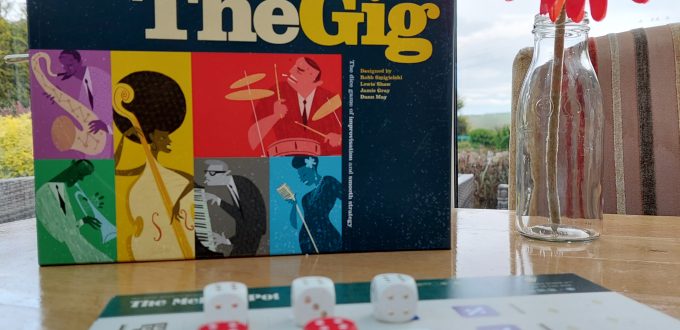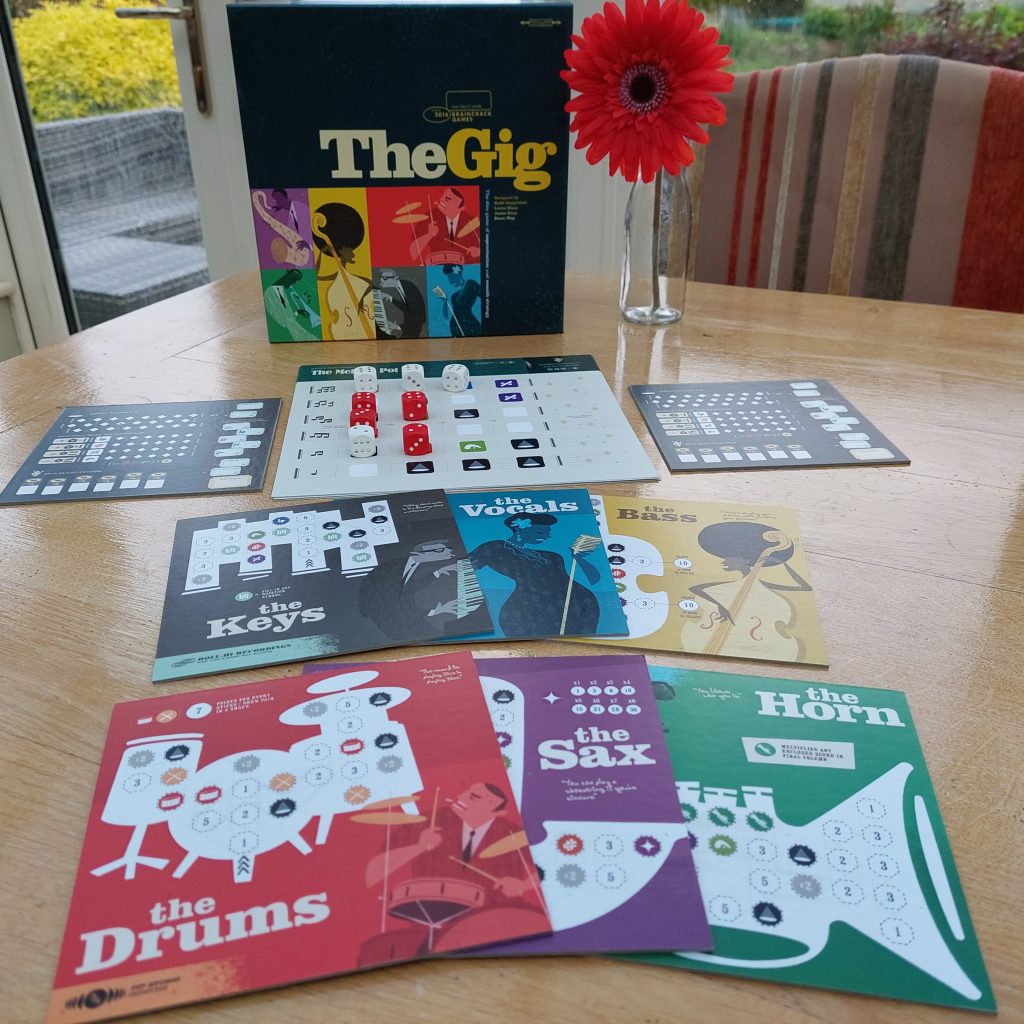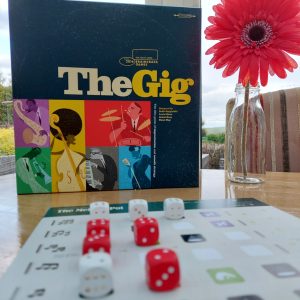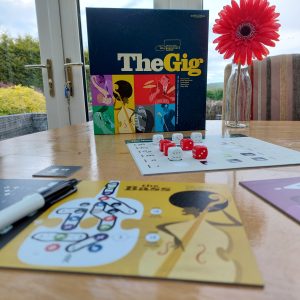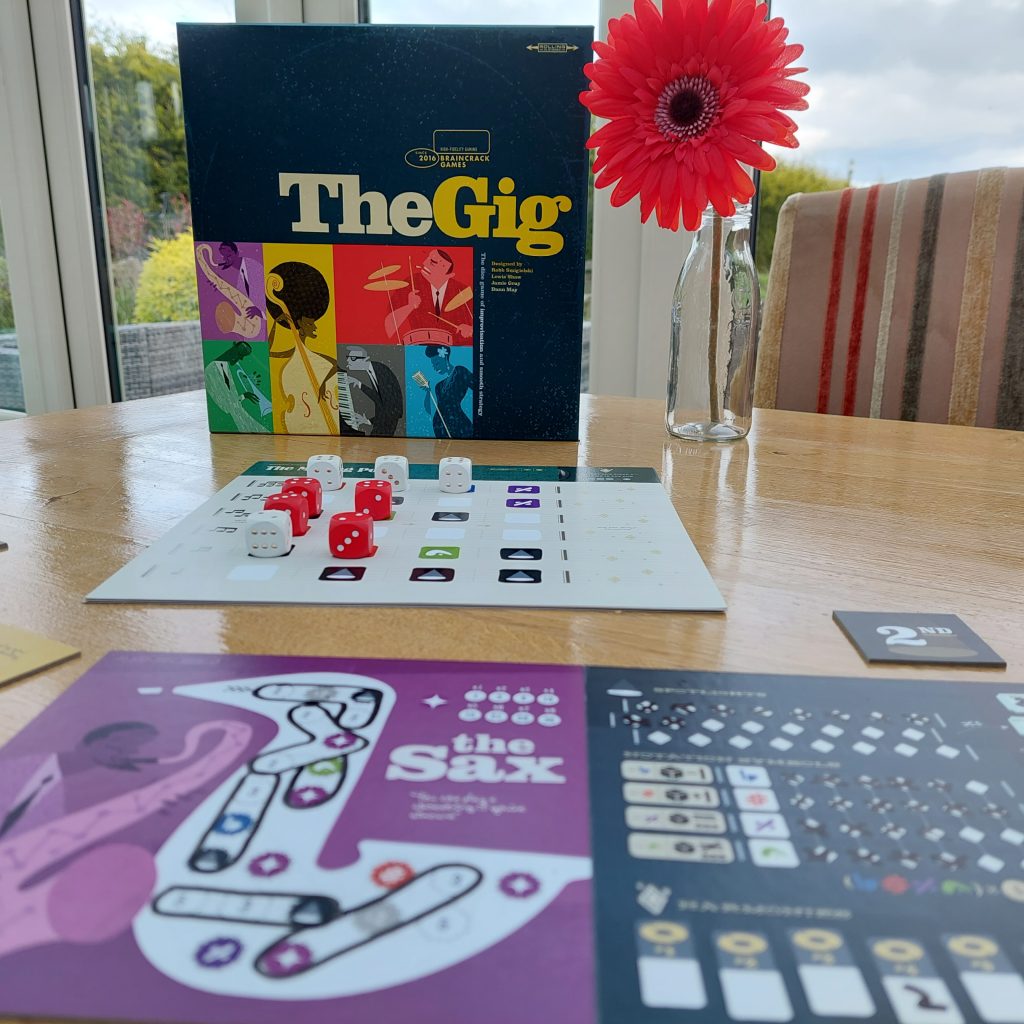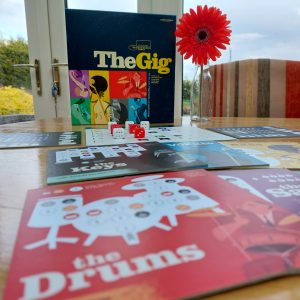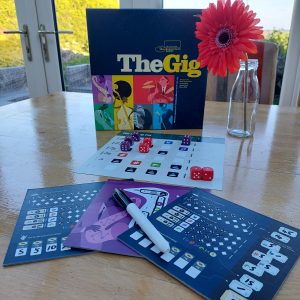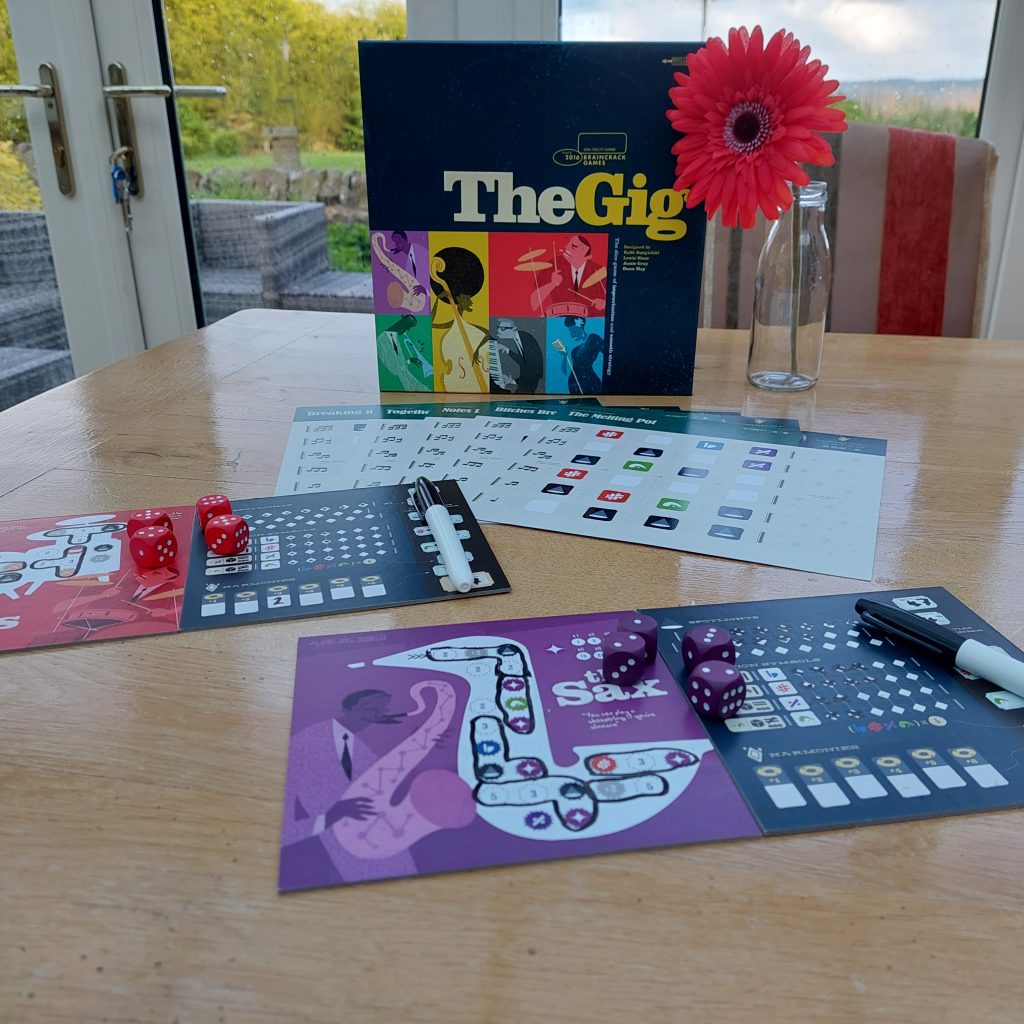We’ve got our shades on and our fingers zinging in Braincrack Games’ jazztastic new roll and write game, the Gig!
Publisher: Braincrack Games
Designer: Jamie Gray, Dann May, Robb Smigielski, Lewis Shaw
Solo Designer: Dávid Turczi
Artist: Dann May, Robb Smigielski, Lewis Shaw
Release date: 2023 (Kickstarter launch 31.5.22)
1-4 Players
Age: 12+
20 mins
*Pattern Matching * Dice Drafting * Strategic * Dice Rolling * Solo Mode * Variable Player Powers * End Game Bonuses * Roll and Write * Real Time * Simultaneous Action * Fun * Fast * Dry Wipe*
Jazzing it up!
Braincrack Games, often known for their mind bending and beautifully produced euro-games, have entered a new stage; the world of roll and write games! And boy, what a banging intro to the genre!
Take your seats, grab your drinks, put on your shades, and cool your jazzy jets, peeps. For today I am going to tell you a little bit more about The Gig!
Just before I grab my sax, however, I must make clear that I have only played a prototype of The Gig. This means that the game and game play I describe could be different to the finished product once the campaign ends, and production begins.
For those who don’t know, Kickstarter is a crowd-funding platform used to get an idea from paper to people. And when it relates to boardgames, it becomes a promise to make and deliver a game based on the ideas the designer is offering if sufficient monies can be raised. As The Gig feels so complete and so cool, I’m hoping nothing major is going to change in terms of the rules between now and then, but never say never! And sometimes inspiration hits like a high note after a campaign smashes its target. So, just to be clear, everything I say is based on the prototype copy I have played.
So with clarification made, let’s ruffle some riffs!
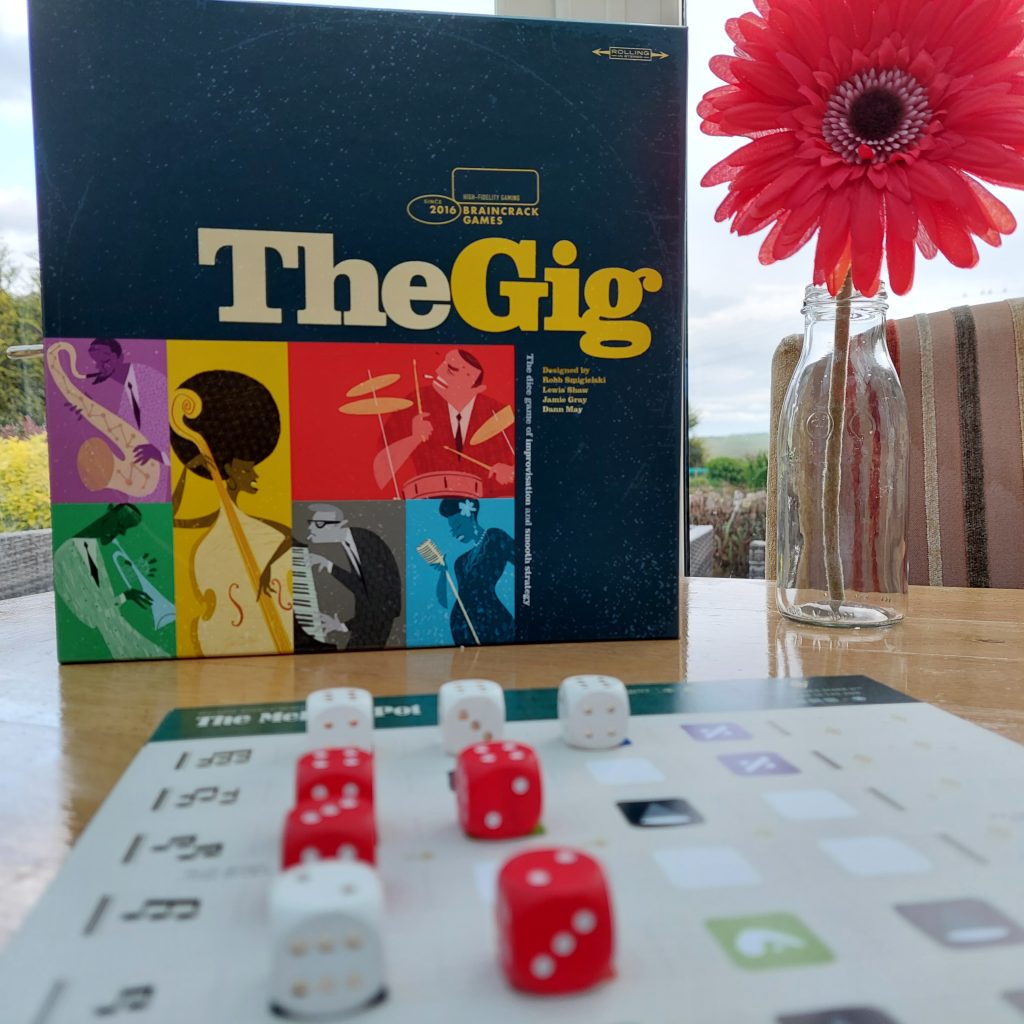
Setting the Stage!
The Gig is a roll and write where you are players in a jazz band doing your cool kat thing. With a set list of just 6 songs out of a possible 15, it’s down to you to maximise the chances you get to blow your audience’s minds before its time to pack those instruments away!
But The Gig isn’t just a roll-tick-score-repeat type affair. Oh no. It’s more musically meta than that! You’ve got puzzles inside puzzles in this feelin-like-Miles Davis-wanna-throw-up-my-jazz-hands-dice-rolling-bonanza!!
Pump the Pedal!
So how does it work?
Well, once you’ve picked your instrument solo board out of the 8 on offer (each of which has their own powers and ways to score when soloing) and you’ve got your personal score board and dice, it’s time to roll some riffs!
NB: I should mention that when I refer to “SOLOING”, it means something a little bit different in The Gig. Although there is going to be a sweeeeeeeet solo mode designed by David Turczi (of Florence and Venice to name but a few!), soloing is actually part of what each of you do every round in multiplayer mode. And it is a polyomino point scoring puzzle that you won’t want to miss, so I’ll be giving a brief rundown of it below under “Phase 2: Get into the Groove!”.
Each round is a specific song from the 6 song set list you’re performing this game. And the main song sheet is where you are all going to be placing your dice, so slide that somewhere every cool cat can see.
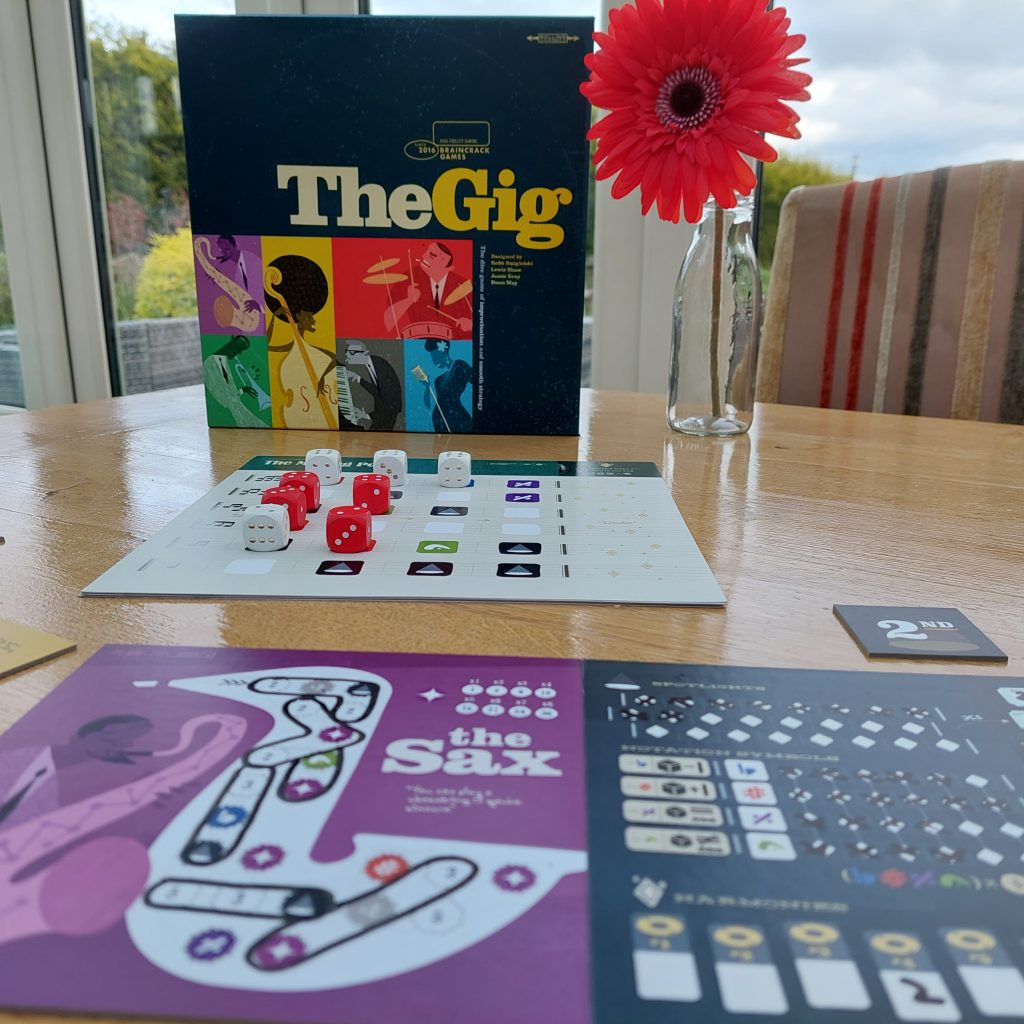
Phase 1; Scat time!
Then someone counts you all in with a “I,2,3,4” and its cue frantic dice rolling and re-rolling time! Each stave on the Song Sheet has a number which corresponds to a die side (I am told the finished game will have musical note pips – cooool, man!!). You can only place one of your dice on that stave if it matches that number but you can choose any spot along the line.
Once the first player triggers the end of the real-time rolling phase by shouting “Take it to the bridge!”, all dice have to be on the Song Sheet somewhere. And that is because any shape that your dice have formed can then be drawn onto your solo board to trigger points, bonus notes, and multiplier effects in Phase 2. Get into the groove!
Now, some spots on the Song Sheet also earn you bonus notes and spotlights that can be banked for end game points or used to manipulate your die results after everyone has stopped rolling. But others are blank. These can still be helpful if you need them to form part of a specific shape (or stop someone else achieving one!). If nothing looks zingy this round, you can add any spare dice to the harmony section of the Song Sheet. It won’t trigger any bonuses or help with your solo, but it will award some straight up points at end game – more if you add to a line with another player already jamming there. And that can be part of some sharp strategy too, man!

Phase 2: Get into the Groove!
Once everybody has finished placing their dice, you can draw your “groove” onto your solo board (first round starting at the arrows). You don’t have to use the whole shape formed by your dice if you don’t want to. But the part of the groove you do select must be composed of adjacent dice. Future grooves must be adjacent to a previous solo too – those riffs need rubbing together for serious heat!
You can also improv by flip reserving the shape if you’re one clever cat! And don’t forget; as well as the usual notations and point indicators, your instrument has its own special way to score. E.g. the Drums score extra if you can enclose drums and sticks in a single groove pattern. So you are going to want to get up close and personal with yours so that you know how to lay down some jumping licks on those tubs, you dig?!
After that, you mark off on your score board everything you have earned that round. And your score board has many different ways to give you some smokin’ hot points, Daddy-o.
Sets of notation symbols, majority bonuses, spotlights, and of course harmonies are all on there. As such, the crazeeeeee free jazz, fast hands dice rolling of phase 1 isn’t the only way to prove your chops! Smoother, slower Kenny G wannabees can also pace their way to player glory with some smart strategic score board choices!
After the 6th song has faded, the game ends and it’s time to score. Whoever has the most points is declared the hippest hepcat of all!
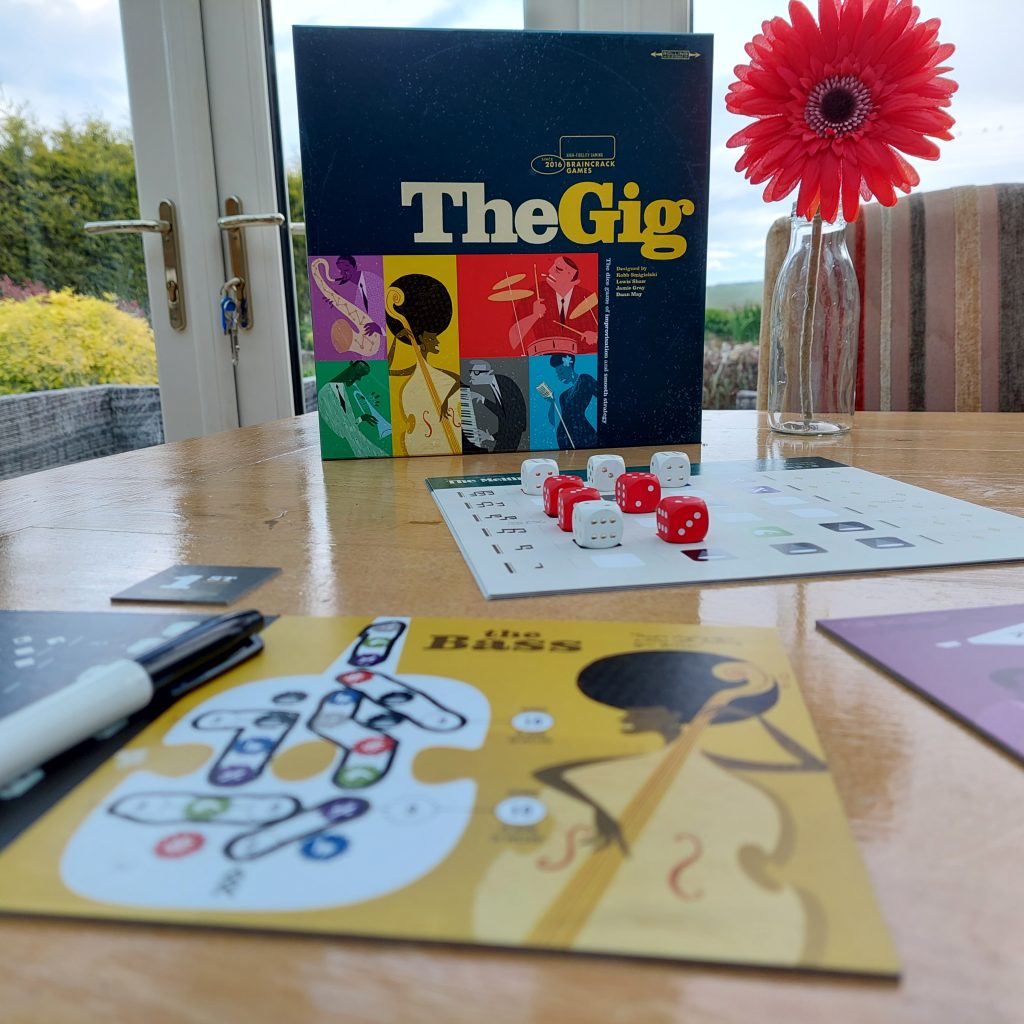
Play it again, Favouritefoe!
When The Gig hit the table, even in prototype form, I had a feeling it was going to be one cool jam. I mean, look at the artwork – it made me wanna put on my shades and zoot suit, man!
And, for all it’s fun, fast and frenetic dice rolling, The Gig is Boney James smooth jamming. The cool theme is flowing through it every which way you look. Set lists, Song Sheets, notations, “Take it to the Bridge” calls…… it’s all very jazz-tastic! I have been told that even the dice are going to have little semi-quaver pips which will look superb! My only concern there is that I hope it doesn’t become difficult to see the values when furiously rolling to get the numbers I want!
I love the fact that each instrument scores differently; a musical super power! I used the piano on my first game and then switched it up with the sax on my second, followed by the drums and then the horn. My strategy completely changed from one to the other as my solo scoring needed me to enclose different symbols for optimal scoring. And that makes the game feel box fresh each time, even when playing the same set list of songs.
Some instruments appear to have very powerful solo bonuses. But overall I think they are balanced out by a reduction in other scoring opportunities. Taking the sax as an example; it has hardly any notation symbols which makes scoring sets tricky. But points for enclosing star symbols ramp up quickly if you can finger zinger your way to building the right groove shapes in phase 1!
Using different set lists for the number of players is another nod to how the designers have thought a lot about balance. With each one showing a different combination of notations on the staves, it feels like they’re designed to maintain tension and amplify the sweetest spots on the Song Sheet regardless of how many or few players are jamming in a given game. Having said that, however, what is going to make your solo sing realistically always depends entirely on your own instrument and what you’re trying to collect. And that in itself is one design element sharp note!
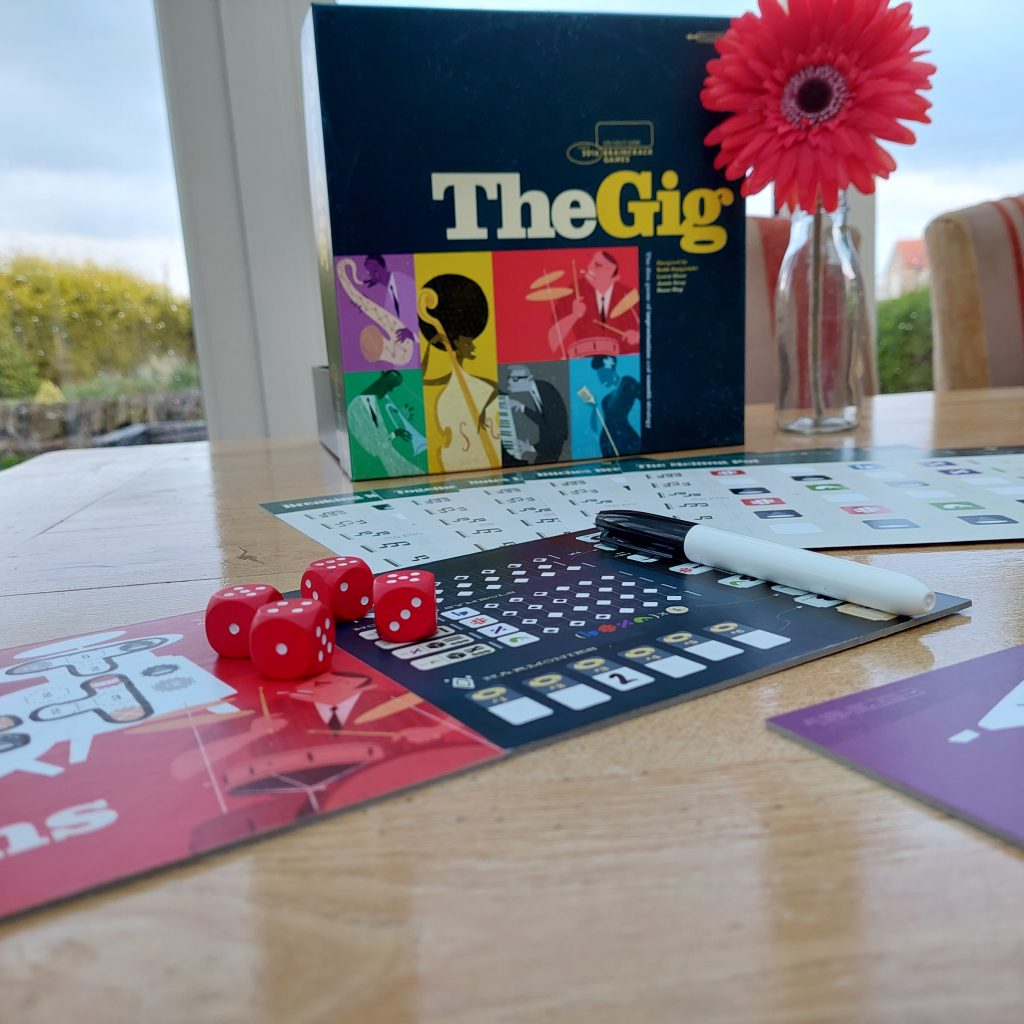
Quick, Slow, Quick, Quick, Slow!
Having played the prototype of the Gig quite a few times now, I think the inclusion of harmony points and majority scoring is another balance marker. For me, it enabled me to gain rewards incrementally even when my real-time dice rolling dropped a clinker or two! And in fact there is even a more chilled, turn based alternative rule set that removes the scat craziness and replaces it with a less directly interactive dice placement mechanism for cool, calculating crunchiness.
The Gig is therefore clever in that it offers choices that don’t simply rely on you always being the fastest around the table. And believe me, when player count goes up, the spaces on the Song Sheet disappear quickly! Although if you do like the pressure to roll right, you can even include a 40 second timer to amp up the stakes even further!
I was left noodlin’ with no mega grooves in a few rounds. But by scooping up some notations and adding die to harmony lines when it was Take it to the Bridge time, I was able to combo some symbols and claw back some serious skin. I was also able to sneek a peak at my opponent in two player mode on a few occasions (admittedly with more luck than judgment!) block a pattern or two when his rolls weren’t quite jamming – I ain’t no rusty gate! Haha
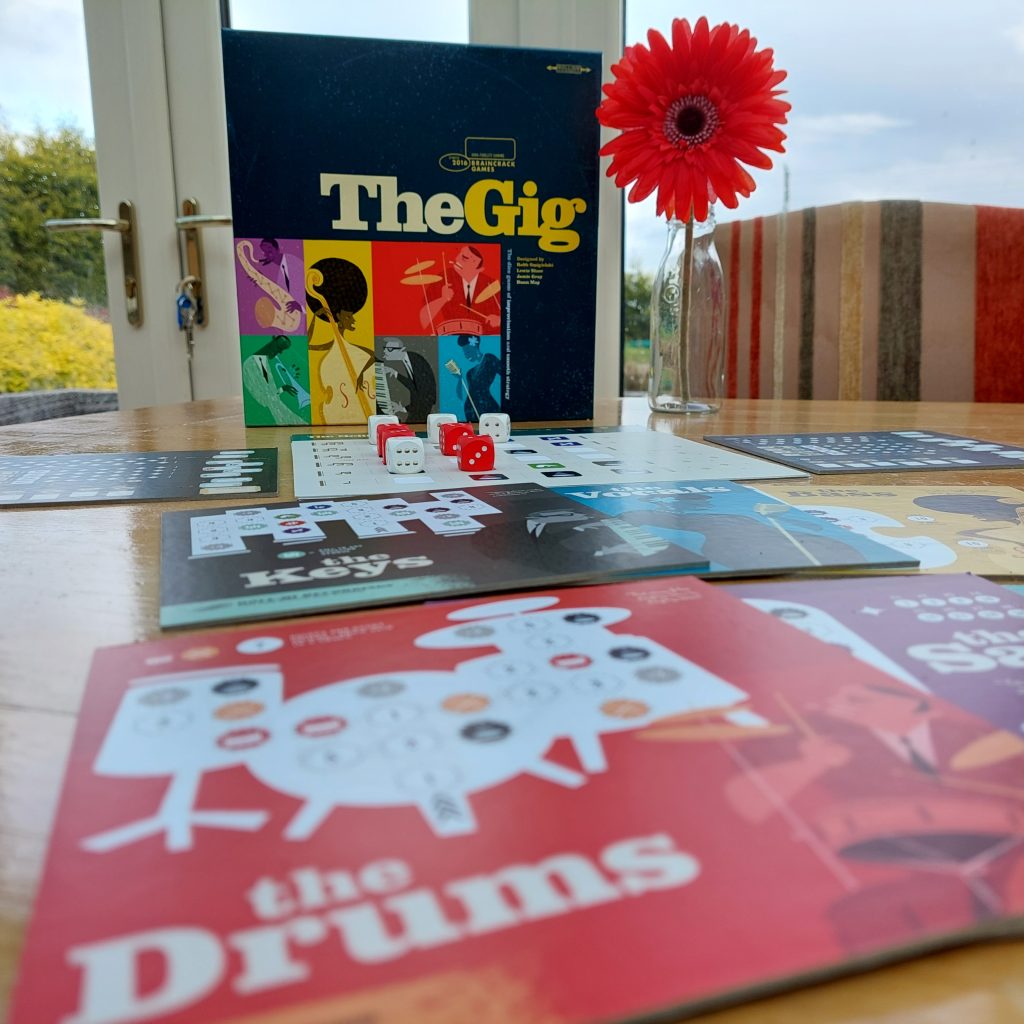
Slick Solo!
As a massive solo gamer with very little time to indulge myself, I was very excited to hear that David Turczi designed the single player variant in The Gig (“The Showdown”). And I can tell you that I have found it to be one challenging session! ?
Very briefly, the AI is prevented from grooving on a solo board and spending symbols to manipulate die results to worry about, so “The Challenger” is all about the value of the notations they can collect on the Song Sheet.
It uses the 2 player Set List, and you roll one of its 4 dice each time you roll your own. But, and here’s the kicker, if the Challenger’s dice result is 1,2,3,4 or 5, you have to lay that dice on the Song Sheet immediately. The rules prescribe to which symbol each number corresponds, and it can be placed on any matching notation symbol on the Song Sheet (unlike you or in MP mode where dice must be placed somewhere on the corresponding numbered stave or harmonies section).
If you like any of your own dice that roll, you can of course place it at the same time as you place The Challenger’s. BUT it will trigger the end of the rolling phase and any unplaced dice for you and the Challenger have to go off to harmonise (which is a whopping 5 points per dice for them!). Placing the Challenger’s 4th dice is also an end of rolling phase 1 trigger, so in solo mode you face the risk of extremely limited rolling opportunities and a lot of harmonies! And this has a knock-on-effect on your groove drawing and point scoring ability. For me, it ramps up the push-your-luck element and restrictiveness of dice placement even further than in multiplayer mode.
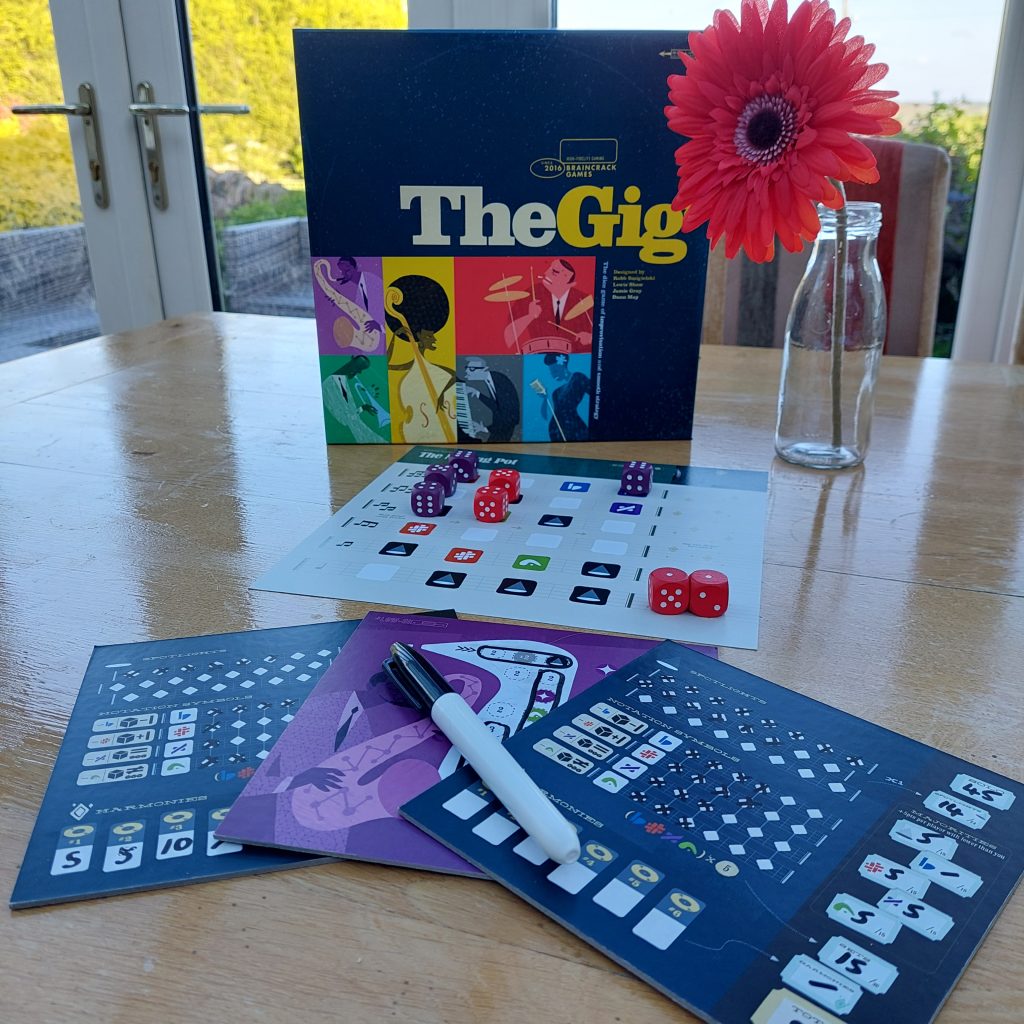
Last Lick!
We are really enjoying jamming with this prototype of The Gig. Six songs on the set list pass so fast that it is one of those “if only I had one more round” type games. It leaves you wanting more. More symbols, more notations, more grooves…… And that means it is a hit in our household.
The Gig is a super easy game to pick up once you get into the groove – I did have a few queries over the solo rules but the designers and publishers were super quick to clarify. Overall, I think I personally enjoy the multiplayer experience in the Gig a little more. With everybody furiously rolling dice and vying to get dice on the Song Sheet spots, it is frantic and frustrating in the most fun way! Snagging a sweet spot on the sheet before anybody else is a mini fist pump moment (or it would be if you had time!). But that is probably just because I lost against the Challenger every.single.time. I’m such a square haha!
The fact that Shadowmeeplemedia and I can’t seem to play the Gig just once – both of us wanting to try our luck lickin’ out on other instruments – is also a sign that we are really grooving with the Gig! The dry wipe boards make resetting a slick process (love dry wipe boards!), and with each game running to just 15-20 minutes, we have no excuse not to play it again, Braincrack!
If this preview and our initial thoughts on The Gig gameplay has fired up your interest, it is going to be launching on Kickstarter for £23 plus shipping. And if you pledge, you’ll get exclusive KS content from the get-go! You can find the Campaign Page by searching The Gig or follow this link here.

